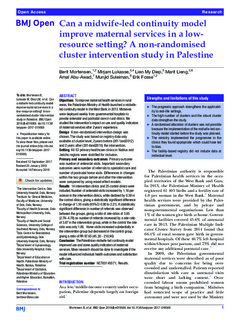Can a midwife-led continuity model improve maternal services in a low-resource setting? A non-randomised study in Palestine
Mortensen, Berit; Lukasse, Mirjam; Diep, Lien My; Lieng, Marit; Abu-Awad, Amal; Suleiman, Munjid; Fosse, Erik
Journal article, Peer reviewed
Published version
Permanent lenke
http://hdl.handle.net/11250/2574954Utgivelsesdato
2018Metadata
Vis full innførselSamlinger
Sammendrag
Objectives: To improve maternal health services in rural areas, the Palestinian Ministry of Health launched a midwife-led continuity model in the West Bank in 2013. Midwives were deployed weekly from governmental hospitals to provide antenatal and postnatal care in rural clinics. We studied the intervention’s impact on use and quality indicators of maternal services after 2 years’ experience. Design: A non-randomised intervention design was chosen. The study was based on registry data only available at cluster level, 2 years before (2011and2012) and 2 years after (2014and2015) the intervention. Setting All 53 primary healthcare clinics in Nablus and Jericho regions were stratified for inclusion. Primary and secondary outcomes Primary outcome was number of antenatal visits. Important secondary outcomes were number of referrals to specialist care and number of postnatal home visits. Differences in changes within the two groups before and after the intervention were compared by using mixed effect models. Results: 14 intervention clinics and 25 control clinics were included. Number of antenatal visits increased by 1.16 per woman in the intervention clinics, while declined by 0.39 in the control clinics, giving a statistically significant difference in change of 1.55 visits (95% CI 0.90 to 2.21). A statistically significant difference in number of referrals was observed between the groups, giving a ratio of rate ratios of 3.65 (2.78–4.78) as number of referrals increased by a rate ratio of 3.87 in the intervention group, while in the control the rate ratio was only 1.06. Home visits increased substantially in the intervention group but decreased in the control group, giving a ratio of RR 97.65 (45.20 - 210.96) Conclusion: The Palestinian midwife-led continuity model improved use and some quality indicators of maternal services. More research should be done to investigate if the model influenced individual health outcomes and satisfaction with care. Can a midwife-led continuity model improve maternal services in a low-resource setting? A non-randomised study in Palestine
Beskrivelse
No commercial use is permitted unless otherwise expressly granted. This is an Open Access article distributed in accordance with the Creative Commons Attribution Non Commercial (CC BY-NC 4.0) license, which permits others to distribute, remix, adapt, build upon this work non-commercially, and license their derivative works on different terms, provided the original work is properly cited and the use is non-commercia.

